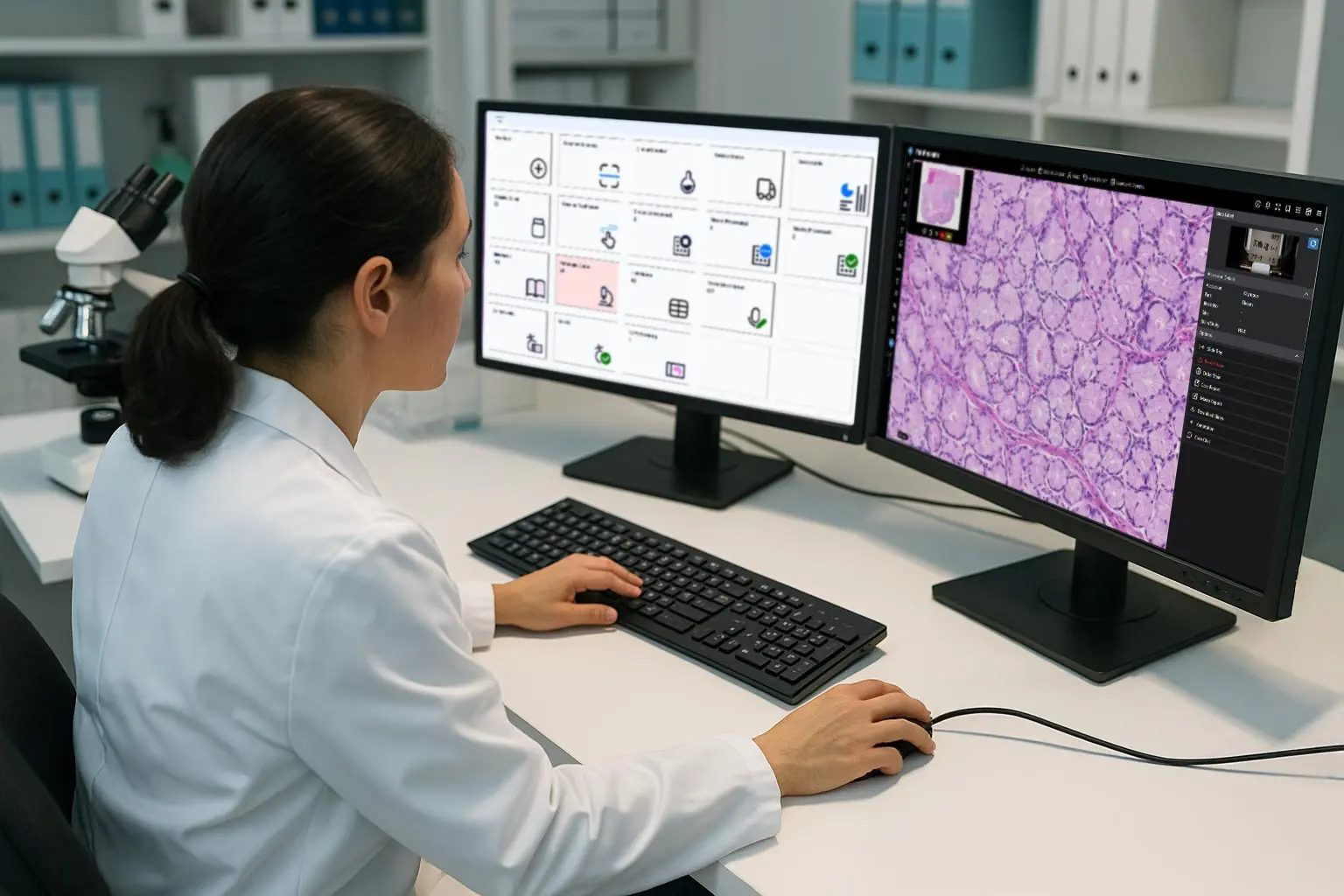Blog
Advances in Digital Pathology
September 17, 2025
Research advances in technology are increasingly being utilized to automate and digitize healthcare processes and laboratory information system software. These advancements have helped speed clinical diagnosis and treatment, thus improving patient outcomes.
One such emerging technology is digital imaging, which has transformed the field of digital pathology by enabling high-throughput scanning of samples collected from patients.
The traditional way of preparing a tissue sample for investigation and LIS pathology management is as follows: A histology tech segments the sample into thin slices and then mounts them onto glass slides. These are next processed to improve the final image quality. The prepared slides are then sent to the pathologist, who examines the samples under a microscope to determine or confirm a diagnosis.
While these steps (are mostly) still followed, digitization has begun to transform anatomic pathology software systems and pathology lab management at the final step by converting the glass slide prepared for microscopy into a more flexible digitized image as part of an exciting new digital pathology workflow.
On-Demand Webinar: Anatomic Pathology LIS Software Product Tour with Allison Still
Defining Pathology Lab Management with Advanced Digital Pathology Solutions
Digital pathology is made possible by digitizing prepared slides and facilitating integrated digital pathology and LIS lab workflow, with the glass slides traditionally viewed under a microscope being replaced by digital images that can be scanned and viewed through a monitor.
Discover More: Pathology Lab Reporting Software and Pathology Lab Management: Enhancing Laboratory Efficiency
In this workflow, a microscope is replaced by a digital pathology scanner, which captures high-definition images of a slide (whole slide images) and transmits the captured images directly to the pathologist's screen via the pathology lab’s LIS software application.
So, what benefits do modern digital pathology solutions offer to progressive pathology groups?
The pathologist can share digital pathology images instantly with the medical team, eliminating the need to move slides between sites by courier. This speeds up turnaround, streamlines operations, and fosters better collaboration, ultimately improving patient care.
Discover More: Introducing LigoLab’s Grossing Workstation Window

Digital Pathology Workflow with Image Scanners
A histology or digital pathology scanner is a piece of equipment that can handle 1,000 glass slides at a time, depending on their size, to capture digital pathology images and then transmit them to the attached screen of a computer.
Scanners should be placed on a stable countertop within the lab, away from vibrations caused by equipment such as centrifuges or stirrers that can distort image quality. Each scanner connects to a digital pathology camera or slide viewer, with an attached monitor and a linked image management system or LIS software application.
Digital pathology scanners can be chosen based on their routine application in the lab. For example, if a pathologist needs images with high magnification (40X), the doctor can use medical lab software that achieves higher magnification.
Image acquisition through scanning is thus accelerated with today’s digital pathology solutions, improving turnaround time for clinical diagnosis within laboratory information systems. Though diagnostic aspects remain the same, today’s digital pathology solutions have increased lab efficiency, decreased costs, and improved clinical lab workflow and pathology lab management.
Discover More: Laboratory Information Management System - Advances in Clinical Lab Workflow
Today’s digital pathology scanners can capture and process images within a minute, adjust them to multiple magnifications, and handle large volumes of slides.
The best digital pathology scanners are customizable to a lab’s needs. Here are two examples of customization labs can now utilize:
Complete Automation: The fully automated process of capturing whole slide images from slide preparation and management to diagnosis and reporting, with minimal or no human intervention.
Semi-Automation: A semi-automated process that integrates manual and automated steps, combining human expertise with digital tools for preparation, management, diagnosis, and reporting.
The scanners should also be compatible with modern pathology lab software and advanced laboratory information systems that automatically acquire, label, and store.
Discover More: Comparing LigoLab Informatics Platform with Legacy Laboratory Information System Software
Digital Pathology Workflow with Image Analysis Software
Through digital image analysis, LIS pathology labs can leverage artificial intelligence (AI) based analytical tools and algorithms to streamline a pathologist’s clinical lab workflow and decrease the chance of human errors that may arise during sample processing.
Analysis of acquired images is semi-automated through digital pathology software, which allows a pathologist to investigate a slide by directly annotating the image with measurements made within the lab information system.
Image acquisition management within image analysis software and pattern analysis on digitized images enable the interpretation of pathology data for clinical diagnosis. Pathologists can evaluate and compare their diagnoses with historical data stored and processed within the same image analysis software or an integrated lab information system.
Diagnostic digital pathology solutions thus support reproducible interpretations, empirical measurements, and increased confidence in the pathologist’s findings.
Discover More: Pathology Software and Laboratory Information Technology

The Many Benefits of Digital Pathology Solutions
Anatomic pathology labs are adopting laboratory software systems that support advanced digital pathology solutions for numerous reasons:
- Taking pathology digital simplifies image-sharing, allowing collaborations among a team of pathologists to accelerate diagnosis times. Digital pathology images can also be transmitted online to other team members for a second opinion.
- Digital pathology images can be instantly, securely, and permanently stored on the cloud. This improves accessibility for peer consultations, for example, yet keeps confidential patient information safe from theft, fire, and other events.
- Digital pathology solutions include analysis tools embedded within the software that can be deployed to measure specific tissue biomarkers that indicate disease empirically.
- Image analysis software utilizes AI to guide review and improve diagnostic accuracy. Cloud storage enables pathologists to compare results with historical specimens and view multiple samples side by side, which strengthens pathology software algorithms.
- Since slides are labeled with a barcode and matched to a patient’s information, there is less risk of misidentification.
- Patients receive their diagnoses faster despite the increasing number of cases that anatomic pathology labs handle.
- Pathologists can enhance their expertise by interacting with the data collected from the samples.
- A digital pathology workflow provides a solid foundation for automation, thus allowing pathologists to implement better flexibility in their work schedules.
- The image acquisition software and digital pathology workflow can be integrated into the laboratory information system software deployed within the lab.
- A secure digital archive of the patient’s sample is stored instead of a slide or frozen section that takes up valuable physical storage space and adds to storage costs.
- Physical samples are subject to degradation, whereas digital pathology ones are not.
Case Study: Summit Pathology - Achieving Laboratory Profitability Amidst Operational Pressures

The Integration of Digital Pathology Solutions and LIS Systems
Digital pathology solutions have advanced rapidly, thanks to the many benefits they offer anatomic pathology groups. One key area of advancement has been seamless integrations between digital pathology applications and laboratory information systems.
The best laboratory information system software is comprehensive and flexible, and labs that operate with modern pathology LIS systems are at an advantage when adding digital pathology to the workflow.
Here are a few of the many advantages that come from a seamless digital pathology - LIS software integration:
- Efficient Laboratory Workflow Management: Digital pathology integration streamlines pathology lab management by allowing the smooth transfer of data and images between two integrated laboratory software systems. This reduces manual steps, minimizes errors, and speeds up diagnostic processing.
- Enhanced Accessibility: Digital pathology enables remote access to images and data, facilitating strong collaboration among pathologists regardless of their locations. This adds a layer of consultation that may not have been possible in the past.
- Improved Accuracy: Digital pathology solutions often come with advanced image analysis tools that assist pathologists with their diagnosis. Integration with advanced LIS laboratory information system software ensures that all relevant patient data is readily available during analysis and easily transferable into the LIS system software, leading to more accurate and comprehensive diagnostic reports.
- Centralized Data Management: The best laboratory information system software works closely with all digital pathology solutions to enable the centralized storage and management of anatomic pathology LIS data within the system database. This improves data integrity, security, and accessibility while simplifying data retrieval for audits and quality assurance purposes.
- Cost Savings: The long-term benefits of digital pathology and lab information system connectability include reduced storage costs for physical slides, improved resource utilization, and potential savings from faster turnaround times and more accurate diagnoses.
- Scalability: Digital pathology solutions integrated with medical LIS system software can easily scale to accommodate growing volumes of cases and data. This scalability ensures laboratories can adapt to increasing workloads without compromising efficiency or quality.
- Compliance: Digital pathology integration with LIS software helps laboratories comply with regulatory requirements by ensuring proper documentation, traceability, and data security measures. This simplifies the accreditation process and reduces the risk of compliance-related issues.
- Patient-Centric Care: By providing quicker access to pathology results, digital pathology integration with anatomic pathology LIS systems supports faster treatment decisions, improved patient outcomes, and more patient satisfaction. Patients also benefit from enhanced communication and transparency regarding the diagnostic process and their test results.
Discover More: LigoLab’s Anatomic Pathology LIS Lab Solutions
The Future of Digital Pathology Solutions
The U.S. healthcare system is under pressure from the massive amount of data produced during diagnostics. To keep pace, labs need advanced digital pathology solutions that streamline workflow and handle growing demands. Machine learning and big data are increasingly being applied to diagnostic pathology, enabling more precise and efficient analysis.
Digital pathology systems can perform complex tasks such as multiplex analysis, which measures multiple markers within the same tissue sample. This allows accurate comparison of signal intensities between markers, something that is difficult to perform manually under a microscope (due to stain diffusion).
These solutions also open integration with other diagnostic methods, enhancing the value of a diagnosis. For instance, biomarker expression identified through digital pathology can be compared with protein expression data from mass spectrometry, creating a more comprehensive diagnostic picture.
With improved image management, modern laboratory information system integration, and evolving policies for data sharing, the potential for digital pathology continues to expand. Cloud storage, virtual microscopy, and AI-driven tools are transforming how pathologists work, replacing older manual methods with faster, more collaborative, and more accurate diagnostics.
On-Demand Webinar: Learn How Modern Anatomic Pathology LIS Software Can Transform Your Lab’s Operations






